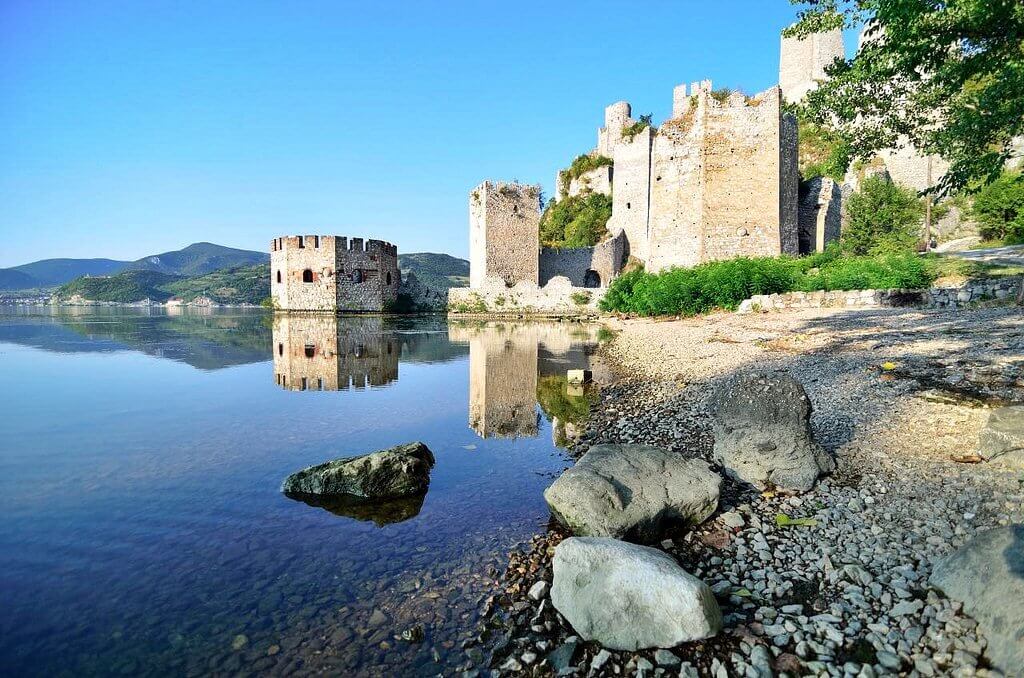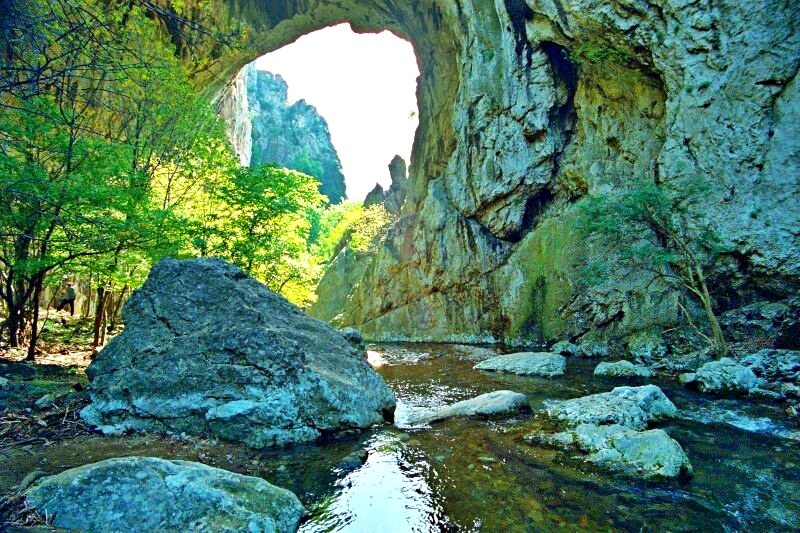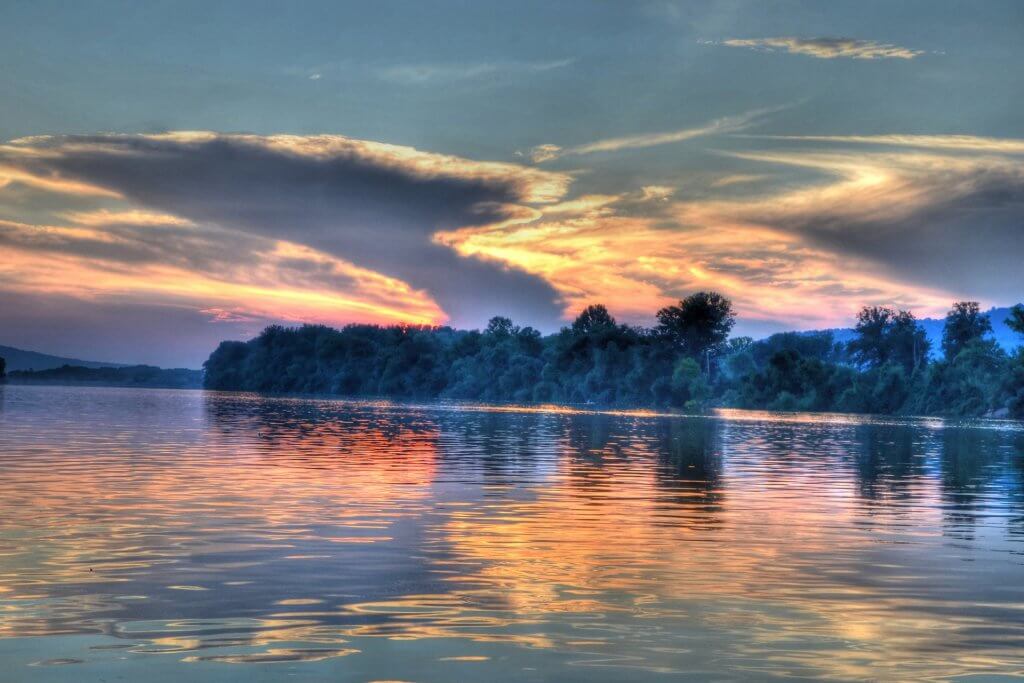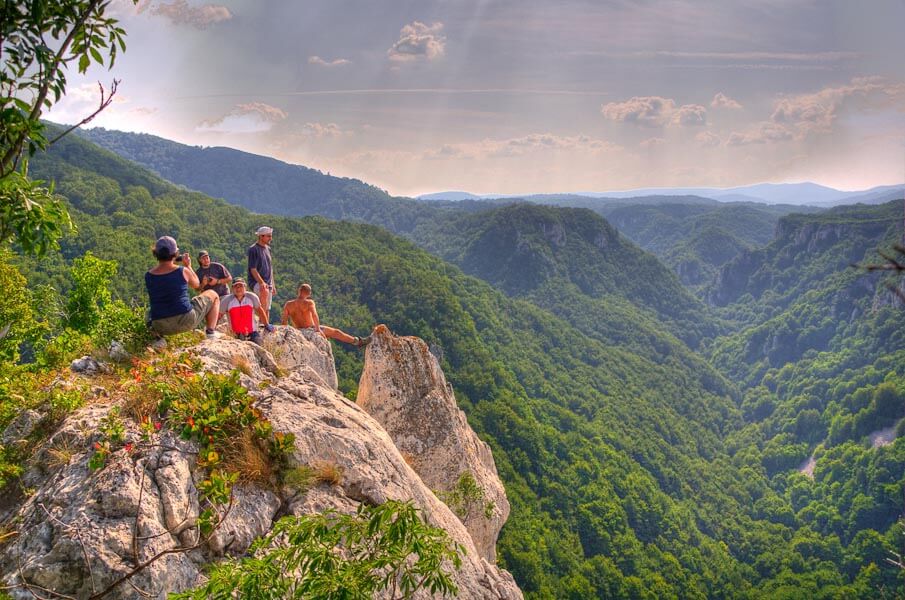A favourable climate, abundant hunting, and fishing territories, coupled with a love and need for the river and its banks, all served to ensure the establishing of a permanent, pre-historic settlement at Lepenski Vir. The art of its residents, in the shape of stone sculptures of fish-like deities, both surprised and impressed the world. The rich and meaningful lives of prehistoric people at the Djerdap “Iron Gate” Gorge, is only the first, prehistoric, evidence of the benefits and beauty of this area – upon which that same mystic power relates to the Homolje, Beljanica and Kučajske mountains…
Djerdap National Park
The Djerdap “Iron Gate” Gorge has been a challenge for thousands of years for travellers, traders, warriors and peacemakers. Its Iron Gate connects two important cultural and economic parts of Europe, making Djerdap a strategic place with enormous importance, both in times of war and peace, as witnessed by a large number of historical monuments. Djerdap is the biggest river gorge in Europe, created where the mighty Danube broke through the Carpathian Mountains and some 90 kilometres long. It is made up of four gorges: Golubac, Gospodjin Vir – which has a tourist centre at Lepenski Vir, Kazan (the deepest stretch of the river at 90 metres) and Sipska, as well as three ravines: Ljupkovska, Donja Milanovac Ravine and Orsavska Ravine. Being such a powerful and intensive centre of life from prehistoric times to the present day has served to make Djerdap National Park the largest in Serbia. This protected area includes ten nature reserves, ten sites of natural heritage, history and beauty, with the great river passing Lepenski Vir, Great and Small Strbac with Trajan’s Tablet, Golubac Fortress, the Bosman- Sokolovac nature reserve, Čoka Njalta with Pesaca nature reserve, Bojana, Tatar Heights, Mount Somrda, Ciganski (Gypsy) Stream and Boljetin River Canyon – Greben Cape. The Djerdap area has always been characterised by an exceptional variety of wildlife, as evidenced by the records of numerous travel writers.

That diversity has been maintained to this day, with the area’s ancient beech and oak forests still offering excellent natural habitats for the lynx, wolf, jackal, white-tailed eagle, eagle owl and black stork, but also deer, wild boar, badger, marten, hare, wood pigeon and dove, among others. Furthermore, the rocky outcrops of the Djerdap Cauldron are home to chamois, eagles and falcons. The River Danube and Danube Lake, broad waters with subtle vortexes and powerful rapids, are a haven and habitat for various species of fish. Thus it’s no surprise that the ancient inhabitants of Lepenski Vir chose a fish-like deity – worshipping the very creatures that they depended on and which assured their survival.
The Iron Gate Gorge and its many secrets offer great possibilities for even the most ardent followers of commercial and recreational fishing with species including trout, sturgeon, perch, catfish, carp, pike and bream. The challenges are great for anglers who may want to try their hand in the Danube whirlpools. A distinctive historical development, very pleasant climate,
A distinctive historical development, very pleasant climate, complex network of gorges, canyons and deep ravines all serve to define this area as a unique European reserve of tertiary flora, fauna and vegetation.
Djerdap’s plant world is not merely characterised by diversity and richness, but also by its distinctive prehistoric relic characteristics. The territory of the park has thick forests that are home to more than 1,100 plant species. Just within the area of the Lepenski Vir reserve, many plant species of scientific relevance have been found, among the rocks. The many herbaceous plants that inhabit the forests, meadows, rocky outcrops and cliffs represent a botanical story of their own, which is especially important in the case of the Djerdap Tulip (Tulipa hungarica). As many as four nature reserves are located in the municipality of Golubac (Golubac Fortress, Bojana, Bosman-Sokolovac and Tatar Heights). They are home to many plant species that are endemic to the entire Balkan peninsula. The richness of animal life is well recorded. Among them are the logged and brown long-eared bat, edible Dormouse and Golubac fly.

Golubac Fortress, which was first mentioned in 1335 as a Hungarian military fortification, adds a distinctive mark of history to this part of the park. Thanks to its diversity and rarities, Djerdap National Park is a real centre of scientific research in nature. The Great and Small Štrbac Nature Reserve, one of the most interesting parts of the National Park scientifically, as well as one of its most attractive tourist regions, has extremely diverse and extensive prehistoric relict vegetation. It also boasts a Roman inscription, known to science as the Tabula Traiana, which is located at the very exit from the Iron Gate Gorge. The inscription dates back to around 100AD and commemorates the completion of Trajan’s military road through the Lower Gorge. The Čoka Njalta along with Pesaca Reserve represents a typical refuge for ancient relic and rare species of trees and their communities, while Mount Somrda provides a habitat for evergreen shrubs of the Phillyrea latifolia genus.
On the territory of the Ciganski (Gypsy) Stream Reserve lies a unique authentic walnut forest, which is surrounded by a mixed composition of beech and walnut and is a true rarity of natural indigenous forest walnuts. Djerdap National Park offers some of the most beautiful health walk tracks in the region, as well as famous viewing points like Okmejdan, Venac (Wreath) and Crni Vrh (Black Peak).
Because of the specific crossed winds and width of the Danube, this area is a veritable yachting paradise, which is why Golubac is the centre of Serbian sailing.
Stone Gates & White Sources
The virtually inaccessible River Vratna Canyon has been long known for its stone gates and unusual whirlpools, which are true miracles of nature. During its course of just twenty kilometres, the picturesque Vratna stubbornly bursts through three natural stone arches, or gates, leaving behind it wonders that geologists refer to as outgrowths.

These Small, Large and Dry outgrowths were described by Austro-Hungarian Felix Kanitz, a famous naturalist, geographer and Balkanologist, as well as a great friend of the Serbian people. One of them even conceals within a small lake of unusual beauty. Šuplja (Hollow) Rock is another magnificent stone bridge that the river formed with its powerful flow. However, the list of geomorphologic wonders of this region does not stop there. Near the Hollow Rock, from the darkness of the cave, flows a small river known as the Beli Izvorac (White Source), which flows over cascading rocks, creating waterfalls of outstanding beauty.
Silver Lake
In the mysterious, undulating, fairytale area near Ram Fortress, where the Danube is more than two kilometres wide and its waters lap against river islands, local fishermen toast the benefits of the river with wine and the river, in turn, gives them life – and it is here the Silver Lake found its place. In the late afternoon hours, when the sun has dipped behind the Carpathians, millions of sparkles of light make the surface of the water shimmer and shine like silver.

This extraordinarily beautiful lake has been a popular regional tourist centre, dubbed the Serbian Sea, since its creation in the 1970s, when a narrow Danube channel along one side of a river island was dammed to create the Silver Lake. Tailored beaches, rich fish life, comfortable accommodation and good restaurants provide everything you need for a totally relaxing holiday. The view from the nearby Ram Fortress reveals the unusual island on the Danube, which is there for a moment, then disappears. Ada Cibuklija is a river island on the Danube that sunk below the surface after the construction of the hydroelectric dam at Djerdap. Ada Cibuklija has an interesting history of its own, as the place of enjoyment for the commander of Ram Fortress, who kept his harem there.
Homolje
The River Mlava flows through Homolje – the mountain region of north east Central Serbia. It originates in Žagubica and part of its course runs through the famous Gornjak Gorge. This canyon is named after the fresh Gornjak wind, which blows along the river through the ravine surrounded by mountains. Visitors are amazed at the very entrance to the gorge by the ruins of the Blagoveštenja (Annunciation) Monastery, which seem to float in front of the vertical rock face it was built into. On the other side of the river, just a hundred steps from Annunciation Monastery, rises another jewel of this area: Gornjak Monastery, the endowment of Serbian Prince Lazar.
Beljanica & Kučaj
The River Mlava flows from Beljanica Mountain and its hot springs and Krupaj Spring are the most important and probably the largest karst springs in Serbia. On the opposite – south side, below the rocky peaks of amazing white colour, after which the Beljanica is named, you will see one of the most beautiful waterfalls in Serbia. The spring known as Veliko vrelo (Great hot spring) and the waterfall known as Veliki buk (Great Cascades) are both protected as a single natural monument of Lisina. Spraying clear, cold water cascades down into the lake. This fast-flowing water tumbles out of the mist and on sunny days you can often see a rainbow.
Lisina’s water flows into the Gornja Resava River, which is inhabited by an extraordinary type of fish, the watermill trout. This clear brook cuts its way through the limestone rocks and the most beautiful part of its course runs trough a narrow canyon that also has the status of a monument of nature. The narrowest part of the canyon is called the Sklop – the rocks are high, almost vertical, and lean towards one another, separated by just a few metres. The nameless waterfalls, vast forests and untouched wild nature of this region are irresistibly reminiscent of ancient times.
Lazarev Kanjon (Lazar’s canyon) is a part of eastern Kučaj. Lazarev Kanjon is important for its relief, its water-formed features and its natural life. It was formed by the erosive action of the Lazareva Reka river, a right tributary of the Zlotska Reka river. This magnificent canyon is carved into the limestone and is joined by the more shallow, smaller canyons.

The Kučaj Mountains stroke Beljanica. On these mountains is the broad Brezovička area with a number of karst coves with unusual underground streams and waterfalls. The most interesting is undoubtedly the Prskalo Waterfall – an architectural work of water that deposits into a cavern. The Resava Cave near the town of Despotovac is one of the most beautiful caves in the country. Its luxurious interior is rich in multi-coloured cave ornaments of red, yellow and white. The dominant red comes from iron oxide, the white from calcium crystals and the yellow from clay infusions.